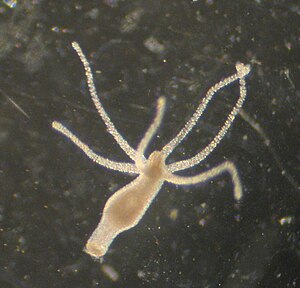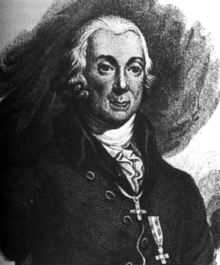Hydra vulgaris
| Hydra vulgaris | ||||||||||||
|---|---|---|---|---|---|---|---|---|---|---|---|---|

Hydra vulgaris |
||||||||||||
| Systematics | ||||||||||||
|
||||||||||||
| Scientific name | ||||||||||||
| Hydra vulgaris | ||||||||||||
| Pallas , 1766 |
Hydra vulgaris is a species of freshwater polyp .
features
Hydra vulgaris is a brownish hydra 5 to 15 mm long, the body of which expands evenly from the wreath of five to 12 tentacles to the budding zone and then merges into the weaker pigmented stalk without a step. The tentacles reach, depending on the state of extension, about half to double the length of the trunk.
Stinging cells
All of the stinging cells of Hydra vulgaris are relatively large. The size of the broad and rounded stenotles (15.8 ± 3.1 × 12.4 ± 2.8 µm) and of the desmonemas (7.9 ± 0.5 × 5.3 ± 0.4 µm) fluctuates significantly clone dependent . The holotric isorhizas are cylindrical to kidney-shaped (12.2 ± 0.8 × 4.8 ± 0.4 µm) and have up to six, but mostly four, thickened first turns of the uterine tube, which are perpendicular to slightly oblique to the longitudinal axis of the capsule stand. The atric isorhizas are cylindrical to oval (9.9 ± 1.1 × 4.2 ± 0.5 µm) with a longitudinally wound tube.
Vegetative reproduction
Hydra vulgaris usually forms one or two, rarely up to four buds , which are arranged alternately or in a slight spiral and in which all tentacles are created at the same time.
Sexual reproduction

In the open ground, sexual reproduction occurs in spring and autumn. In general, the individuals are unisexual, but the sex change occasionally occurs. Testicles and egg spots can be placed next to buds in small numbers or in larger numbers, whereby the bud formation is suppressed. In male individuals, up to 20 testicles are created in an irregular arrangement, which begin as small white, elliptical elevations and grow within four days to arched structures with clear nipples, the tips of which swell several times and give off sperm . They disappeared again after seven to eight days.
In female animals, one to three or six glandular egg spots are created, in the center of which the egg cells are formed. The embryo has very variable, often forked spines that reach about one eighth the diameter of the egg and often remain on the mother for a long time.
In the rare hermaphroditic individuals, testicles and eggspots appear disordered along the trunk.
distribution
Hydra vulgaris occurs on all continents except Antarctica in fresh water at temperatures of 7 to 29 ° C. In Europe, the distribution area includes the mainland and the British Isles.
Taxonomic history

The first descriptions of freshwater polyps are from 1704 by Antoni van Leeuwenhoek and an anonymous author, the former probably describing Hydra oligactis and the latter probably describing Hydra vulgaris . In 1743 and 1744 Henry Baker and Abraham Trembley respectively described a further green species ( Hydra viridissima ) in addition to these two species and in 1755 August Johann Rösel von Rosenhof described four species, one orange-yellow, long-armed ( vulgaris ), one brown ( oligactis ), one green ( viridissima ) and a new pale, short-armed ( attenuata ) polyp. In 1746, Carl von Linné mentioned a Hydra viridis in the Fauna Suecica and in 1758 coined the binomial name Hydra polypus in the tenth edition of Systema Naturæ . In 1766, Peter Simon Pallas described the four species already mentioned by Rösel as Hydra vulgaris , Hydra oligactis , Hydra viridissima and Hydra attenuata and thus coined the species names that are valid today, but without going into Linnaeus' Hydra polypus . This in turn described the four named species in 1767 in the twelfth edition of Systema Naturæ as Hydra grisea , Hydra fusca , Hydra viridis and Hydra pallens . Subsequently, various authors described numerous other Hydra species and used the names assigned by Pallas and Linné inconsistently, so that at the turn of the 20th century there was great uncertainty about the assignment of the Latin names to the species. After several attempts to clarify the systematics of freshwater polyps, Paul Schulze summarized the existing knowledge about species and characteristics in a systematic review in 1917 , but assigned the name Hydra vulgaris to a rare hermaphrodite, still not clearly identified hydra , and the name Hydra attenuata of the Hydra vulgaris by Pallas. In later works he summarized these two forms as subspecies of a species, i.e. Hydra vulgaris vulgaris and Hydra vulgaris attenuata . In 1989 Richard D. Campbell finally clarified the identity of the species described by Pallas. In older works, Hydra vulgaris is therefore often referred to as Hydra attenuata or Hydra vulgaris attenuata . Today the Hydra magnipapillata, described by Itô in 1947, is usually regarded as conspecific with Hydra vulgaris .
literature
- Thomas Holstein, Peter Emschermann: Cnidaria, Kamptozoa . In: J. Schwoerbel, P. Zwick (ed.): Freshwater fauna of Central Europe . tape 1/2 + 3 . Gustav Fischer Verlag, Stuttgart, Jena, New York 1995, ISBN 3-437-30625-1 , p. 82-88 .
Individual evidence
- ^ A b Thomas Holstein, Peter Emschermann: Cnidaria, Kamptozoa . In: J. Schwoerbel, P. Zwick (ed.): Freshwater fauna of Central Europe . tape 1/2 + 3 . Gustav Fischer Verlag, Stuttgart, Jena, New York 1995, ISBN 3-437-30625-1 , p. 82-88 .
- ↑ James H. Thorp, D. Christopher Rogers (Eds.): Thorp and Covich's Freshwater Invertebrates: Ecology and General Biology. Volume 1 of Thorp and Covich's Freshwater Invertebrates . 4th edition. Elsevier, 2014, ISBN 978-0-12-385027-0 , pp. 162 .
- ^ Richard D. Campbell: Taxonomy of the European Hydra (Cnidaria: Hydrozoa): a re-examination of its history with emphasis on the species H. vulgaris Pallas, H. attenuata Pallas and H. circumcincta Schulze . In: Zoological Journal of the Linnean Society . tape 95 , no. 3 , 1989, pp. 219-244 (English).
- ↑ hydra vulgaris at WoRMS